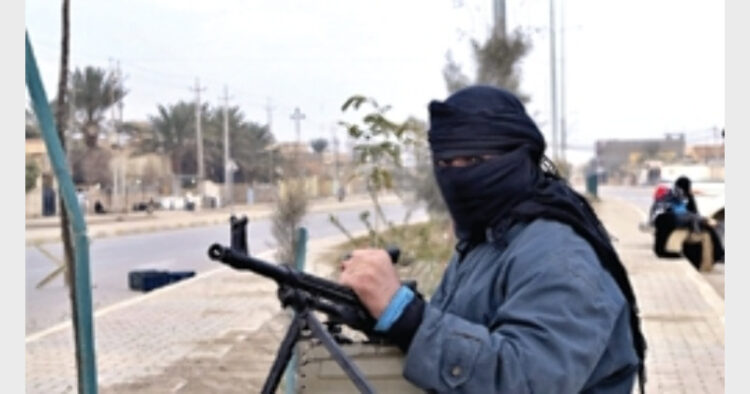Cover Story Related:Iran and rise of ISIS-Tactics or Strategy
Intro: Terrorists today are well equipped with science and technology- result of which they are becoming anti-human elements and are gradually emerging as the biggest threat to the world.
The seemingly sudden rise of the Islamic State of Iraq and al-Sham (ISIS), its capture of important cities of Iraq north of Baghdad, control of large areas of Iraq and Syria and the declaration of its leader al-Baghdadi as the Khalifa of the Islamic umma has sent tremors across the whole region and beyond. Iran has sent drones, Russia has supplied Sukhoi jet fighters and the US has despatched 300 military advisors, all to shore up the beleaguered Iraqi government. These developments have coincided with a complete breakdown of the political process in Iraq; months after the national elections were held.
There seems no way forward still as far as, government formation is concerned. Meanwhile, the Kurds have withdrawn from the government of Nouri-al-Maliki citing the latter’s provocative statements and complicity in the fall of Mosul.
Clearly, these are not good times for Iraq. The situation is highly complex with internal issues over the years leading to this implosion. At the margin, external actors, Iran and Saudi Arabia have influenced the flow of events, but neither seems to have factored in the negative consequences of their policies. It is a classic case of tactics being mistaken for strategies.
Iran’s important role goes all the way back to 2003, and was in a way instrumental in the US invasion of 2003. Back then, the US lacked ground intelligence and were heavily reliant for sensitive information on the notorious power-broker Ahmad Chalabi and his Iraqi National Congress. His inputs convinced CIA, and through them President Bush, that Saddam had weapons of mass destruction (WMDs). Unknown to the US and possibly to Saddam himself, Iraqi scientists had dismantled the WMD programme in line with UN resolutions, but at the moment, the US stood convinced and used this to justify the invasion. Within weeks they realised they had been duped, Chalabi’s offices and homes were raided, he was disgraced but the US stood trapped in the quagmire- it turned out, Chalabi was very close to the Iranian establishment.
The other piece of ‘information’ that Chalabi gave the Americans was that the persecuted Shia majority was so desperate that that they would welcome the US army. The then US Deputy Defence Secretary, Paul Wolfowitz, an expert on West Asia, agreed with this assessment, which was made public. The reality turned out to be the opposite. Saddam’s persecution of the Shias was a reality. When the Americans turned on the heat on al-Sadr, he simply skipped out of Sadr city, his stronghold, and based himself in Iran- on whose behalf he had been acting all along. The result was that the Americans were first provided dodgy intelligence for that they were looking for, and were then firmly trapped in a situation from which there was no easy withdrawal. The US’ attempt to link Saddam with Al-Qaeda was misconceived to begin with, but it landed up creating circumstances for the latter to begin operations in Iraq.
Having learnt from their unsuccessful attempts in Afghanistan to craft an inclusive political set-up, the US did craft a complicated consensus among the Iraqi political elite. A parliamentary democracy requiring formal alliance making among parties with key position distributed amongst different religious sects/ ethnicities was probably the only viable way forward.
The powerful Prime Minister was to be a Shia, a Sunni would be the Speaker of Parliament and a Kurd would hold the ceremonial office of President, for example. This arrangement allowed both feuding Kurdish leaders to be accommodated and also demonstrated that this was a federal set-up.
However, with Nour al-Maliki becoming prime minister and replacing Iyad Alawi in 2010, this fine balance started unravelling. Nour al-Maliki distanced himself from the US. He moved closer to Iran, and acted as their proxy. In the bargain, Iran emerged as the main arbiter in domestic Iraqi issues, with even president Jalal Talabani having to go to Teheran to help arrive at compromises. Simultaneously, anti-Sunni armed militias started to operate and target senior Sunni political leadership. They were even targeted politically. A Sunni vice president Tariq Hashemi had to flee the country.
The end-result was that the Sunni heartland, particularly the large province of Anbar, which had worked with the Americans to eliminate Al-Qaeda, turned against the Iraqi government.
The conflict in Syria spilled over in the ungoverned parts of Iraq, and with the ISIS fighting the Iran-supported Assad regime—congruence of interests developed between the Sunni groups in Iraq and the ISIS. The result – Iraq itself is facing severe challenge.
Saudi Arabia has in its own way being instrumental in the rise of the ISIS. Removal of the minority Alawite regime of Assad has become an article of faith for the Saudis and other Arab states as a way to keep Iran down and enforce their primacy in the Muslim world. Today, the ISIS is focussed on removing two Shia-run countries but like Al-Qaeda, a Frankenstein unleashed cannot be controlled. Those who argue that autocracies, unlike democracies, can think long-term would be hard pressed to explain Iranian and Saudi actions in Iraq and beyond.
Lt Gen (Retd)
-Shakti Sinha (The writer is a retired IAS officer)














Comments